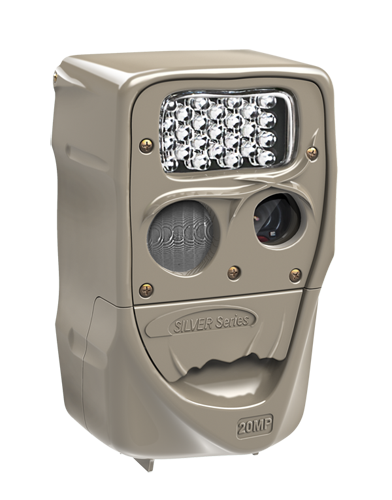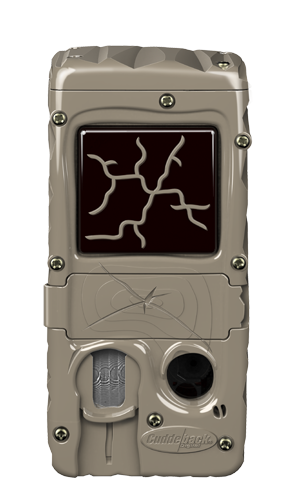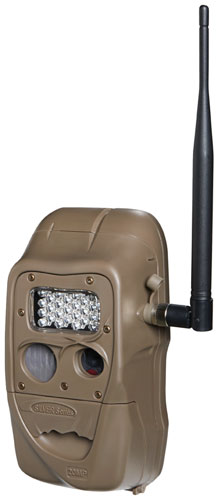From public land to private permission to large-land whitetail hunting, having the right trail camera for the job is a key ingredient to success.
Given how the popularity of game surveillance has grown, I wouldn’t be surprised if some colleges across the country start offering a four-year degree in Trailcamology. Since their introduction in the mid-1980s, these handy devices have become somewhat of an obsession for land managers, hunters and biologists.
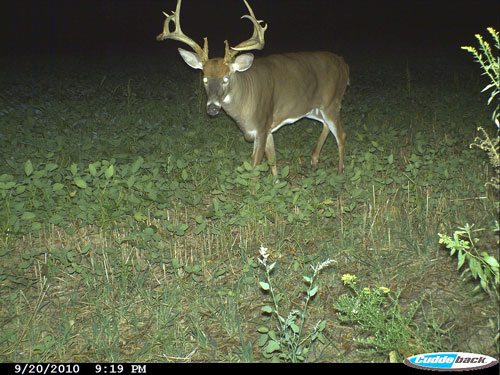
Color images at night? Yep, it’s possible via the Dual Flash 20MP Model G-5017 Model’s Color Strobe feature. (Photo credit Jace Bauserman)
It’s not hard to see why. When you can place a compact device in the woods that keeps tabs on game movement 24/7/365, it’s kind of a no-brainer. Today’s cameras provide year-round battery life, increased detection range, faster trigger speeds and quality images. Some even send images directly to tablets and smartphones.
Recently, I had the chance to sit down with Mark Cuddeback. Mark has been a pioneer in the trail-camera game from the beginning — he’s been designing and innovating since 1984.
“I started tinkering with trail cameras in ‘84,” Mark said. “I developed my first film camera that year. Once I realized how beneficial these devices were going to be to hunters, I really dove in. In 1989, I founded Non Typical, Inc. and began selling the DeerCam. Since those first film cameras, we’ve designed a number of digital cameras showcasing the latest trail-camera technologies, as well as a mesh network that allows 15 remote cameras to send images to one single home camera. We want to make cameras that work for every situation and for every hunter.”
It was the words, “a camera that works for every situation and for every hunter” that struck me. The cold, hard truth is that finding a place to put a camera or two is getting harder and harder. Hunters and land managers with access to vast, manageable acres of whitetail nirvana make up a very small percentage of the population. And as more leases pop up and it gets harder to gain permission to hunt simply by knocking on doors, many hunters are forced to seek their whitetail dreams on public land.
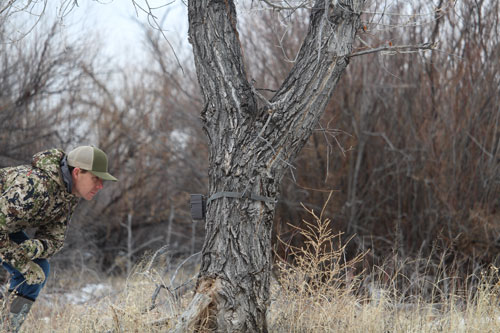
This may work as a lead, but could also be used inside with the caption: Cuddeback’s Dual Flash 20MP Model G-5017 is a good go-to when hunting private ground. The camera promises clear 20-megapixel images and the customizable flash provides three flash settings. (Photo credit Jace Bauserman)
Here’s the good news: I hunt public land in multiple states every year. I may be naive, but I like to think that people are mostly good, and though there are some bad apples in the group, I feel like hunters are some of finest people on the planet. Over the past six years, I’ve only had two cameras stolen off of public hunting land. Not too bad.
Of course, this isn’t just going to be about choosing cameras for public-land hunters. The trick is developing a trail-camera system and matching the type of camera that you’re using to the type of land you’re hunting. Let’s dive in.
The Public-Land Crowd
As I mentioned before, I hunt a lot of public land for whitetails every year, and although tracts are getting a little more crowded, there is still some great hunting to be had for the deer hunter willing to put in the work.
My public-land whitetail trail-camera plan is simple. If I can make a preseason scouting mission and get some cameras hung in likely deer haunts, I do. If a scouting foray is out of the question, I show up, hang some cameras and a few stands, and get down to the business of deer hunting.
Cuddeback makes a great camera choice for the public-land crowd. The 20MP Cuddeback IR H-1453 features ¼-second trigger speed, day and night settings, a flash range of 100 feet, IR Flash technology and a time-lapse mode.
When hunting public land, especially if you plan to hang a camera midsummer and return during the fall, I recommend a 32 GB card. With eight lithium AA batteries, battery life on these cameras is excellent, and the slight red IR flash glow doesn’t seem to bother game.
When you do make that scouting trip and leave a few cameras (always check state game and fish regulations), you don’t have to worry about being out a ton of money if you show up and find some jack wagon with sticky fingers wandered by. You get quality day and night images of the deer you’ll soon be hunting and have a great jumping off point upon your arrival.
Public-Land Camera Tip 1: If you’re planning to leave your cameras for an extended period of time, hang them high and angle them downward. Doing so makes them less obvious to both camera thieves and deer. There are multiple trail-camera mounting systems on the market that make hanging and tilting cameras a breeze. I also lock each camera to the tree.
Public-Land Camera Tip 2: If you didn’t make that preseason trip and simply show up to hunt, hang a camera near each of your stands. (The cameras don’t have to be right on top of your stands.) This way you can monitor one stand while hunting another. I always carry an SD card reader that plugs into my cell phone so that I can view images immediately. This provides me with the MRI (Most Recent Information) and tells me right where to be.
Trail Camera Etiquette
It goes without saying that if a trail camera isn’t yours, don’t take it. That also includes the camera that has been hanging on the same tree in the same public-land area for years. It’s not yours, and it should be left alone.
I’ve been tempted, when hunting both public and private ground, to open a trail camera I happen upon and scroll through the images, but that too is wrong. You didn’t go through the work of hanging the cameras, and you haven’t been scouting the area like this person has. Simply turn around and go looking for a new spot.
What if you’re scouting an area and come upon a camera? Even if you don’t sift through the pictures, should you hang your own camera right on top of it? I will leave that for you to decide, but think about how you would feel if you’ve been putting in the work on public land, your cameras are out and your stands are hung, and one day you come in to find someone has hung their camera right next to yours and put a treestand in the tree adjacent from yours. Yes, it’s everyone’s land, but let’s keep it classy.
Small-Property Permission and Hunting Leases
I have a small lease in Oklahoma, and I’ve gained permission to hunt small whitetail tracts in my home state of Colorado, as well as Nebraska. When hunting any type of private ground, I like to upgrade my cameras a bit. The chances of one being stolen are slim, especially on leased ground, and I like to have a few more camera operation functions at my fingertips.
A good go-to is Cuddeback’s Dual Flash 20MP Model G-5017. Although this unit offers buttons rather than a dial, it’s super easy to set up and its digital display is clear and functional. A 20-megapixel game camera that can be configured as an IR, Black Flash or Color strobe, this camera offers incredible customization. In addition, it features a ¼-second trigger speed, a 100-foot flash range and optional color nighttime images. The image quality is incredible, and images are stamped with the time, date, temperature and moon phase.
Permission-Based Property Camera Tip: Chances are that you will be sharing the property you gain access to with other hunters. You may know them and you may not. Years ago, I avoided those who shared the property with me like the plague. I didn’t want them to know where I was. That proved to be a mistake. I found myself inadvertently hanging stands right next to their stands, walking into their setups, etc. Do yourself a favor — reach out to those you share the property with and tell them about your plans. Not only will they appreciate it, but together you can study the property, spread out your cameras, share images and place yourselves in the best possible locations to ensure that you’re not hunting right on top of each other.
Hunting Lease Camera Tip: You can argue that a cellular system or something along those lines would be best for a hunting lease, and I don’t disagree. The problem that I have is that my little slice of Oklahoma heaven is only 80 acres, and there is zero cell phone coverage. But, when you hunt an area, you often meet people. Take advantage of those meetings. Be friendly. You might gain a new hunting partner, and you could end up befriending a local who will swing by and check your cameras while they’re out checking theirs. It’s a win-win.
Big Property
I don’t have it, but I want it. For those that do have it, Cuddeback has designed the perfect system. Checking trail cameras on vast acreage takes time, and the more often you do it, the more human scent you’re leaving behind. The CuddeLink Cell system allows large-property owners to set out up to 16 trail cameras, and have those 16 cameras transmit their images to one home collection device that is equipped with a cellular modem. This is all done on a single cellular plan. The benefits to the system are many, but the biggest is the fact that you don’t have to put any pressure on your deer hunting land.
For those that don’t want to go the cellular route, CuddeLink offers another service that still minimizes in-the-woods intrusion, but doesn’t operate on cell service or wireless internet access. CuddeLink networks can use anywhere from one to 15 remote cameras. The remote cameras transmit images via a proprietary mesh network to a single home camera. This camera can be placed in an easy-to-access area that can be checked day or night without spooking deer. This unit is also an option for hunters who have large leases that they can visit often. According to Cuddeback, the typical transmission range in timber is a quarter-mile to a half-mile. This range increases in open spaces, and CuddeLink automatically daisy-chains cameras to extend their range to more than four miles, making it possible to run cameras on properties that are thousands of acres in size.
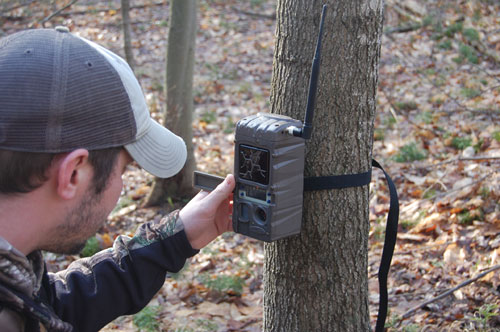
The CuddeLink system allows users the ability to have up to 15 different cameras sending images to one lone home camera that can be placed in an easy-to-access location. (Photo credit Jace Bauserman)
Big-Property Camera Tip: When investing in a system like CuddeLink or CuddeLink Cell, be sure to take a long look at the cameras that are compatible with the system. The CuddeLink Cell Series will work with the cellular plan, while the CuddeLink G and J Series work with the CuddeLink system. For more information, visit www.cuddeback.com.
Rigorous Testing
Toward the end of our conversation, Mark detailed the intense testing that he puts his cameras through — testing that will put your mind at ease when you get ready to pull out your hard-earned greenbacks.
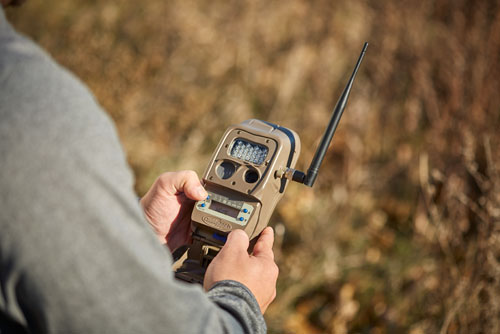
Acting as a mother ship, the home camera easily stores all of your images in one convenient location. (Photo credit Jace Bauserman)
“I own property, and at any given time, I will have from five to 30 cameras out and running,” he said. “My property is located in northern Wisconsin where January temperatures can drop to negative 30 degrees Fahrenheit. That’s without factoring in the wind chill. This is a tough environment, but it’s a great place to test battery life and the overall function of the cameras we put out there for the consumer.”
Cuddeback has options that produce positive scouting results for whatever type of land you hunt. Save up some coin and make a trail-camera investment in 2019, heed the advice in this article and make this season your most successful yet.


